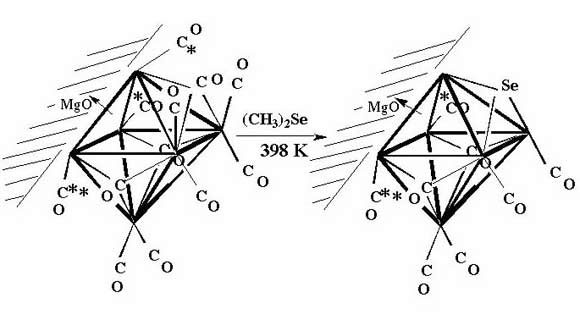
Chiba University > Graduate School of Science > Department of Chemistry > Dr. Yasuo Izumi Group
Selenium-Doped Rh6 Carbonyl Clusters on MgO: Structures and Promoting Effects in Ethene Hydroformylation |
Selenium-modified Rh6(CO)16/MgO catalysts were prepared by the reaction of Rh6(CO)16 on MgO with Me2Se gas in order to examine the promoting effect of an electronegative additive on well-defined Rh catalysts for ethene hydroformylation. The deposited Se (Se/Rh6 = 0.6) enhanced the rate of propanal formation by 1.9 times compared to the case free from Se. The selectivity of the hydroformylation was improved from 20 to 50% by the addition of selenium. On the contrary, the monotonous suppression of ethane formation was observed by increasing the amount of Se. Further doping of Se reduced also the hydroformylation activity. TPD, FT-IR, and Se K- and Rh K-edge EXAFS revealed that the Me2Se reacted with the Rh atoms of partially-decarbonylated [Rh6] clusters on MgO, forming Se-Rh bonds at 0.244 nm. XPS data suggested that the oxidation state of selenium was -1, while the Rh was in nearly metallic state. CO adsorbs also on the rhodium atoms bonded to Se, which is contrasted to the blocking of the neighboring Rh sites by Se atom in the case of impregnated Rh catalysts prepared from Rh salts. The structures of the Se-undoped and doped [Rh6] clusters on MgO are presented in relation to the active site of the cluster catalyst. The data indicate an advantage of molecular clusters over impregnated particles in adsorption capability and catalysis.

Chiba University > Graduate School of Science > Department of Chemistry > Dr. Yasuo Izumi Group